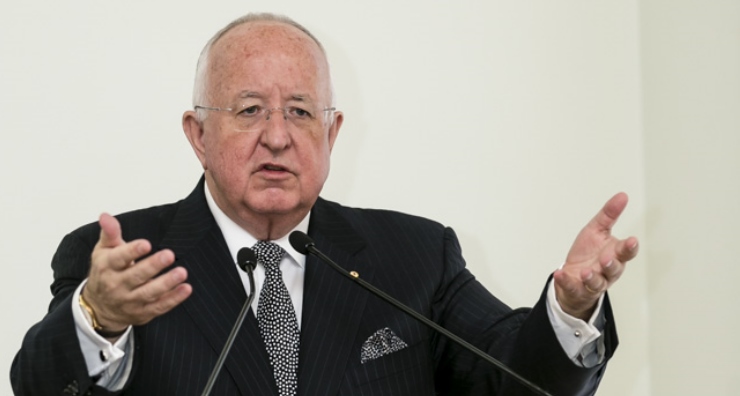Driving commercial and political engagement between Asia, the Middle East and Europe
Driving commercial and political engagement between Asia, the Middle East and Europe
Driving commercial and political engagement between Asia, the Middle East and Europe

A focus on innovation and partnerships with Asian companies have been critical to Rio Tinto’s success to date.
Making a keynote speech at the Partnering with Asia for Global Innovation conference held at Asia House, chief executive of Rio Tinto Sam Walsh AO explained the importance Rio Tinto placed on innovation.
“We are perhaps unique amongst the mining companies in that we place a premium on innovation. We consider it a point of differentiation and competitive advantage,” he said.
But innovation was about having “an open mind and looking outward, not inward”.
Without the use of Asian expertise, for example, Rio Tinto would not have achieved any of the innovation that it has done.
“To me innovation is having eyes that look far afield. Innovation does not occur by looking inward,” Walsh said.
Citing examples of Rio Tinto’s success in innovation, he relayed how the company discovered brown and pink diamonds at its Argyle mine but successfully marketed them, with one rare red diamond weighing 1.42 carats, recently selling for US$2.5 million, he said.
The Anglo-Australian mining giant also uses Big Data to analyse performance in mines across the world from its Brisbane Processing Excellence Centre, which has generated US$80million worth of savings in its first year of operations.

Sam Walsh AO, chief executive of Rio Tinto, gave a keynote speech at the ‘Partnering with Asia for Global Innovation’ conference. Photo by Miles Willis
“We are continuously searching for ways to lower costs, improve safety and productivity and reduce our environmental footprint,” he said.
Some people think of mining as “a sooty-faced man, lamp in hand, pick-axe in the other,” Walsh continued.
But mining is not like that anymore. “These days you’re more likely to see a young engineer – as likely to be a woman as a man – sitting in front of a computer screen, remotely operating driverless trucks or directing precision mining equipment from thousands of miles away. Modern mining is cleaner, greener and leaner than ever,” he said.
At Rio Tinto’s Mine of the Future in Pilbara, Western Australia, for example, robotics, remote sensing and Artificial Intelligence are used – all operated by people sitting 1,500km away in Perth. More than 50 driverless trucks roam around the 14 mines, using ironically 40 per cent less fuel than if the trucks had a driver.
“We wouldn’t have arrived at any of this innovation were it not for Asian expertise, Asian ingenuity and Asian partnerships,” he added.
It was Japanese truck manufacturer Komatsu that manufactured Rio Tinto’s driverless trucks.
“We’re proud of how we’ve been moving mining forward. But we haven’t done it alone. And our partnerships with Asian companies are at the heart of the advances we’ve made. Asia is our largest consumer market, one of our most important commercial hubs and a growing source of talent and innovation for our business,” he added.
“There are more patents being developed in China than there are in the entire world,” he continued.
He then spoke about how Rio Tinto had established a partnership with Chinalco, the Chinese state-owned mining conglomerate. “Rio Tinto is the only global mining company partnering to explore for minerals in China – using technology created at Imperial College in London,” he said. “We’ve used our partnership with Chinalco to share best practice.”
He added Rio Tinto had “20 projects active at the moment, from underground visualisation, to new technologies in ports and even the use of drones” at its Rio Tinto Innovation Centre in Pune, India.
“Engaging with communities is a very important part of what we do – giving locals jobs and buying and selling to local businesses. Last year we spent US$331 million on community projects – health, education, environment and nutrition. Not all innovation is technology. The innovation of negotiating with indigenous communities as landowners has reshaped the way we work,” he added.
Rio Tinto always looked at a wider world to expose new connections and new possibilities, he said.
“That’s why every rush of globalisation also produces a wave of innovation. When the world looks out and collaboration increases, ideas emerge,” he said, explaining how companies like Rio Tinto and Coca Cola were born in the late 19th century during a rush of globalisation.
“Innovation is not an optional extra. If you haven’t got innovation in your business, before long you’re not going to have a business,” Walsh concluded.
All photos were taken by Miles Willis.
naomi.canton@asiahouse.co.uk
To read Sam Walsh AO’s full keynote speech that he delivered at Asia House click here.
To read a private interview that Sam Walsh AO gave to Asia House after the conference click here.
